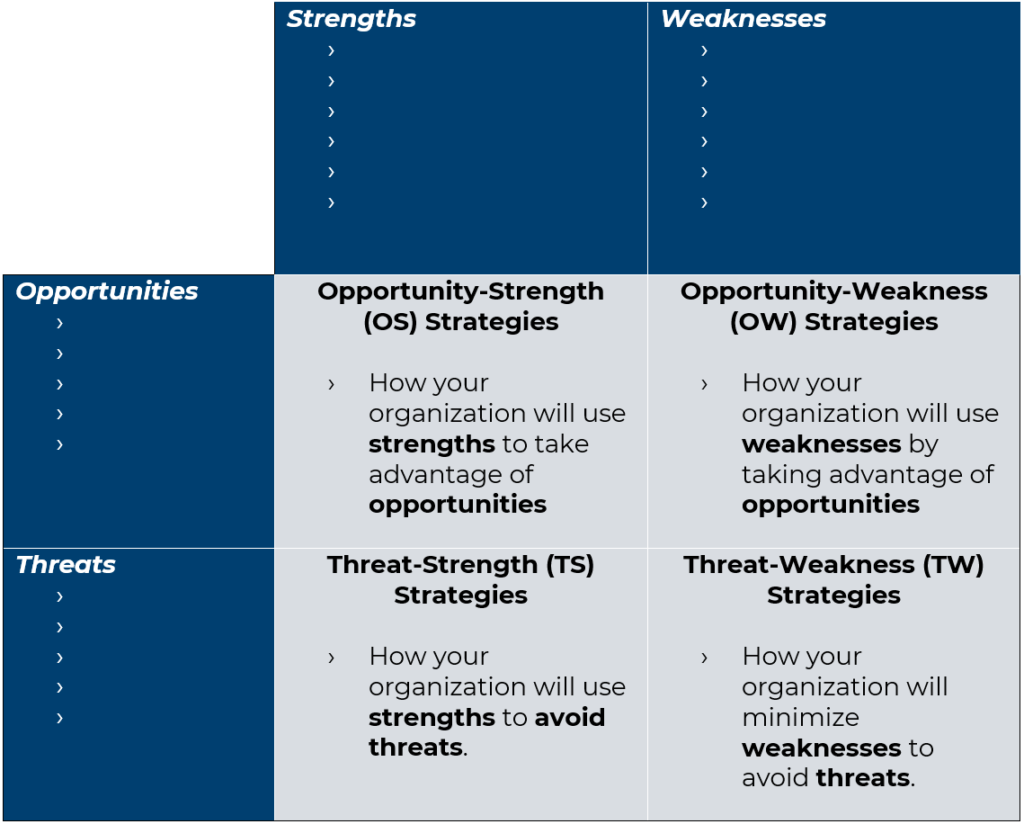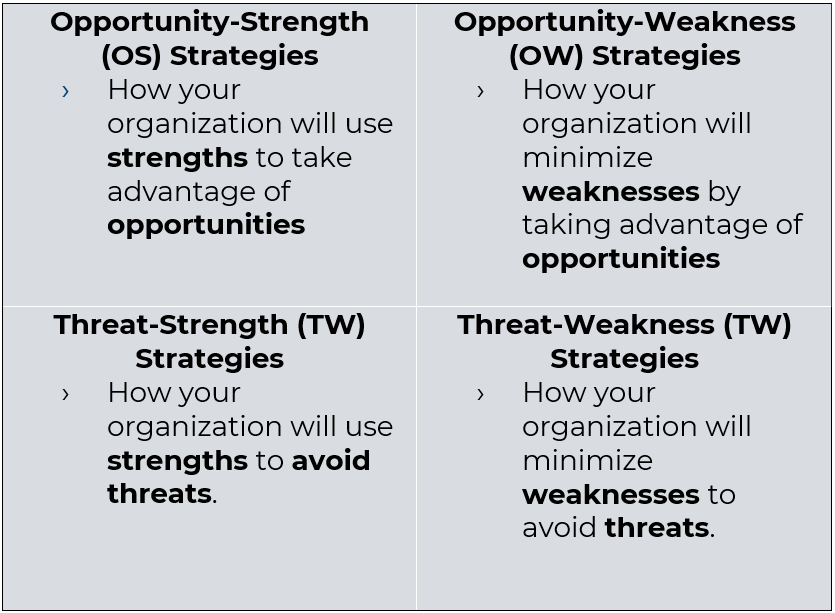Strategic decision-making is not a talent or inherent skill. It’s a process that requires practice, expertise, and the participation of stakeholders.
But how do we begin to address strategy when the world we do business in is chaotic and unpredictable? It’s critical that our decision-making accounts for these outside forces as well as the diverse expertise of subject matter experts.
The SWOT analysis is one tool that addresses all these moving parts. It allows us to brainstorm the internal and external forces affecting our business and points us towards a relevant strategy for success.
In short, SWOT is a way of evaluating your organization based on four variables:
- Strengths (Internal)
- Weaknesses (Internal)
- Opportunities (External)
- Threats (External)
The SWOT is typically represented on a grid with four quadrants, as shown here:

SWOT analyses are helpful in guiding strategic, executive-level decisions; project management; general problem-solving; and a whole lot more.
The SWOT is most effective with a specific goal or purpose in mind. The more you can narrow down this goal beforehand, the better. Relevant goals for this analysis might be to:
- Explore possible solutions to problems
- Adjust and refine plans relevant to newly presented opportunities
- Whether to introduce a product or service to a specific market
- Revisit internal policies
- Determine where change is possible/recommended in relation to a specific initiative, such as:
- Possible expansion to new territories
- New product development
- Internal or external process improvement
This is not an exhaustive list of topics. Not to mention, the SWOT is also useful in personal decision-making.
In fact, the traditional “Pros vs. Cons” list is actually a form of a SWOT analysis. The advantage of the SWOT format is that it more clearly categorizes the “pros” and “cons” and gives actionable insights. Unlike a “Pros vs. Cons” list, the SWOT will show you where to move forward (or hold back) instead of forcing you to infer what path to take.
Now that you have an idea of the advantages of a SWOT analysis, it’s time to learn how to take the first steps towards gathering your results. But first: logistics.
How to Conduct a SWOT Meeting
Before getting into the details, it’s important to understand:
- Who should be involved
- Your specific objective
- How to run the meeting
Participants
The more diversity in seniority, job function, and area of expertise, the better. What’s obvious to someone in the financial department may not even be on the radar of someone in marketing.
Someone who just started with the company will often bring fresh perspectives and insights that would go unnoticed by those with more tenure.
The lamentable phrase, “This is how it’s always been done” exemplifies this.
Setting
For this meeting, you want people to be as open-minded and creative in their thinking as possible. Out-of-the-box solutions rarely happen in silos.
Some of the best settings to conduct a SWOT meeting are outside of the office where participants are at ease:
- A corporate retreat
- Team outing
- Other internal company events
Because a lot of the SWOT analysis requires an open mindset and creative thinking, the more your team members feel comfortable sharing insights, the better.
When team members are in office during the day, they are typically focused on reinforcing the values and strategy of the business. Generating new ideas to change that structure is not natural, especially when we’re preoccupied with the work in front of us.
By hosting the meeting off-premises, these inhibitions are more likely to go away and encourage creative problem-solving in your participants.
Process
Once you have your location for the meeting reserved, it’s time to begin the process of collecting feedback from your team.
- Elect a facilitator with good listening and group process skills.
- For larger groups, designate a note-taker to keep track of your team’s inputs.
- Introduce the SWOT method and your purpose for conducting the meeting.
- Divide stakeholders into groups of varying seniority and expertise. This ensures a diverse range of insights that will better inform your action plan
- Give the groups 30 minutes to brainstorm their strengths, weaknesses, opportunities, and threats.
- Reconvene the group to share results. Keep track of inputs on a whiteboard, presentation, or whatever format is ideal for your organization.
- Discuss and record results.
- Find agreement on the most relevant/high priority items in each category.
- Relate the SWOT to your goals, mission, and/or vision for the organization.
- Translate the SWOT into action items.
- It may be useful to prepare an executive summary of the SWOT to share with participants.
Step 1: Outline Your Experiences
Strengths are what they sound like. Here, you want to account for internal strengths. In the context of business, you should ask yourself questions like:
- “What differentiates us from the competition?”
- “Which industries do we excel in?”
- “Which areas of expertise do our employees represent most?”
As a starting point, strengths could take the following into consideration:
- Personnel
- Physical resources – facilities, location, equipment
- Financial health
- Processes
- Industry Experience
Weaknesses should address similar categories. In some instances, you could invert many of the questions already posed above:
- “What differentiates the competition from us?”
- “Which industries are we struggling to break into?”
- “Where are our knowledge gaps as an organization?”
By framing this first part of the conversation from your own vantage point, you’ve already begun to build the foundation for an action plan. The next step is a matter of knowing your business, industry, and the current socio-economic landscape.
Step 2: Brainstorm Your Landscape
The next thing you’ll do is look outwards at the external forces that will have a direct effect on your company. These could be things happening in the here and now, or forecasted variables that will impact your business in some way.
Opportunities and Threats really go hand-in-hand. These are the factors outside of your group’s control, good and bad. Some areas to consider include:
- Trends in your industry or geography
- The local, national, and international economy
- Legislation/politics
- Alternative sources of revenue – donations, grants, etc.
- Current events and public opinion
- Changes in demographics/customer base
Chances are, your project or business will likely be affected by all the above (and then some). It’s often better to cast a wide net here than have too narrow of a focus.
Whereas your desired outcome should be well-defined, these external forces can have a previously unforeseen impact on that goal. Think of the effect that the Suez Canal blockage had on microchip shortages or the way Covid impacted in-person operations, as examples.
Events that seem unrelated to your business at first can butterfly into larger issues that you’ll want to avoid.
In thoroughly exploring these forces, you may have follow-up questions that require further research to verify accuracy. After all, this exercise is about making informed decisions!
Step 3: Consolidate Your Feedback
Now that we’ve built the foundation of our SWOT, it’s time to begin thinking critically. If you’ve worked as a larger group, you may elect leads to prioritize the most relevant inputs.
Refer once more to the outputs below for another look at how the 4 categories interact with each other:

Your organization and the participants of this exercise will be the only ones who can make informed, actionable insights based on the initial conversation.
Some strategies will be apparent immediately; others will require more in-depth brainstorming. Hopefully, you will have at least affirmed what you already knew to be the right course of action.
If you find that your SWOT recommendations go against that, it’s an even bigger win, because you’ve saved your organization from taking the wrong course of action. At the very least, you’ve uncovered complexities that were hidden from view before.
SWOT in Review
The SWOT analysis is a useful method for consolidating and sharing viewpoints that guide strategy. If you’ve approached this exercise thoroughly, it will represent a series of strategic insights that will help you decide where to go (or not to go) next.
When so much of our success is reliant on factors outside of our control, identifying those factors is half the battle to making decisions in the best interest of the organization.
